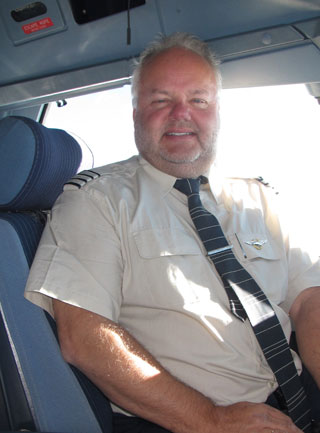As an F-16 pilot for Norway's air force on the Cold War frontline, Morten Kjellsevig led the way in intercepting Soviet Flankers. Now flying A340s for Scandinavian Airlines, he also runs his own safety training company.
What attracted you to flying and how did your aviation career begin?
 |
|---|
Kjellsevig says his experience as a pilot is vital to his safety training work |
As an F-16 pilot in the north of Norway in the 1980s, you were on one of the Cold War "frontlines". That cannot have been dull?
There was never a dull moment. Being on constant 15min readiness alert, we always knew Russian bombers could pass the coast at any moment, and we would have to intercept them. It was the Cold War, but in the air we were fliers meeting in international waters - they waved to us and we waved back. It was a great time and I still remember the intercept on 7 January 1987, when we were told to go supersonic. This was rare so we understood there was something special and were shocked to see two Sukhoi SU-27 Flankers. My lead and I were, in fact, the first pilots in the Western world to intercept the Flanker. But it was not always fun. On 13 September 1987 I intercepted the Norwegian P3 Orion that had crashed with a Flanker. It had serious damage and one engine out. Luckily they managed to land safely. This event was a reminder to all of us that we had to be cautious and professional out there.
You now combine flying Airbus A340s for Scandinavian Airlines (SAS) with running your own safety training company. How did that start?
I launched my safety training company ScandiAvia in 1995. I was still working for the air force when I was asked to make a presentation to Volvo Aero Norway. I gradually started to design new courses and in 2005 it really took off. Now there is quite a demand and more of my training is conducted inside the airlines themselves - it lowers the airline's cost, and you can train a lot more personnel. However, I could not have done this without my job as an active pilot, and flying long-haul Airbuses for SAS is perfect for me.
You studied in London. Has that helped your career?
The Masters degree at City University has definitely helped me a lot. When consulting with ScandiAvia and teaching throughout the world, I am often asked about my credentials and background. Before my MSc, I had to reply: "Mostly self-taught, with some one or two-week courses." I often felt CAAs saw this as insufficient. Now I can say I have an MSc in aviation safety, and being awarded it by a highly-regarded educational facility always helps. City University runs a Masters degree that is perfect for someone who also has a job in aviation. The fact I also lecture on two of their modules allows me to meet enthusiastic students many times a year - it is inspirational.
What do you like best about working in the aviation safety field and what is your proudest achievement?
Flying is very important to me but I also like teaching and meeting the students, which inspires me as a lecturer and pilot. As an active pilot I have a good overview of what is happening in the industry and can relay that to the students. In the air force I worked hard to make the generals accept that a zero-accident rate is the way to go. Even though I am the first to admit it is not always possible, it should be the goal, and I was made promoter for the air force's zero-accident vision. In May, I was elected chairman of the Norwegian Operational Forum and look forward to arranging safety conferences in Oslo.
Source: Flight International






















